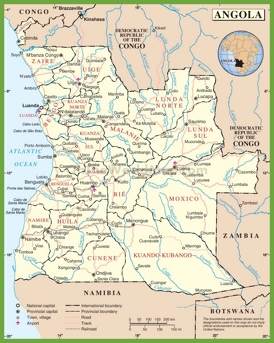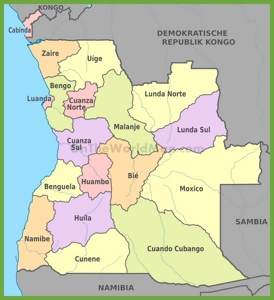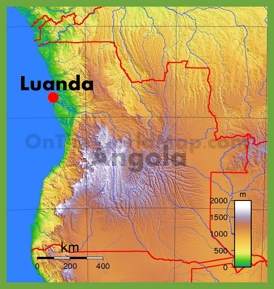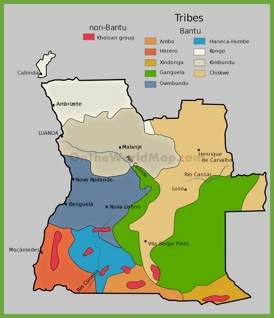Angola Map
Description:
This map shows governmental boundaries of countries; provinces, province capitals, major cities and in Angola.
Size: 970x970px / 224 Kb
Author: Ontheworldmap.com
You may download, print or use the above map for educational, personal and non-commercial purposes. Attribution is required. For any website, blog, scientific research or e-book, you must place a hyperlink (to this page) with an attribution next to the image used.
Online Map of Angola
About Angola
Angola, located on the southwest coast of Africa, covers an area of about 1.25 million square kilometers (481,400 sq mi). It is bordered by Namibia to the south, Zambia to the east, the Democratic Republic of the Congo to the north and northeast, and the Atlantic Ocean forms its western border.
Luanda, the capital and largest city, serves as Angola's political and economic center. Other key cities include Huambo, known for its agricultural importance, and Benguela, a major port city that facilitates trade and commerce.
Angola's economy is largely dependent on its rich natural resources, especially oil and diamonds, which serve as major sources of income. Oil production dominates the country's economy, making Angola one of the leading oil producers in Africa. The government has made efforts to diversify the economy by focusing on sectors such as agriculture, manufacturing and infrastructure development to achieve sustainable growth.
Tourism in Angola, although still in its developmental stage, has great potential due to its diverse landscapes and cultural heritage. Highlights include the Kalandula Falls, one of Africa's largest waterfalls, and Kissama National Park, home to an abundance of wildlife. The coastal city of Benguela attracts tourists with its beaches, while the country's capital, Luanda, offers a mix of modern and colonial architecture. Angola's rich cultural traditions, including music and dance, also provide tourists with a unique experience of the country's vibrant heritage.
The Facts:
Capital: Luanda.
Area: 1,246,700 sq mi (1,246,700 sq km).
Population: ~ 36,000,000.
Largest cities: Luanda, Lubango, Huambo, Benguela, Cabinda, Malanje, Saurimo, Lobito, Cuíto, Uíge, Moçâmedes, Luena, Soyo, N'dalatando.
Official language: Portuguese.
Currency: Kwanza (AOA).
Provinces of Angola: Bengo, Benguela, Bié, Cabinda, Cuando Cubango, Cuanza Norte, Cuanza Sul, Cunene, Huambo, Huíla, Luanda, Lunda Norte, Lunda Sul, Malanje, Moxico, Namibe, Uíge, Zaire.
Driving side: right.
Calling code: +244.
Internet TLD: .ao.
Time zone: UTC+1 (WAT).
Website: www.governo.gov.ao.
Google Map of Angola
Geography of Angola
Angola's geography is a diverse landscape comprising coastal plains, high plateaus and arid regions. The western part of the country is a narrow coastal plain along the Atlantic Ocean, transitioning into the central highlands, where elevation reaches 2,620 meters on the Bie Plateau. Due to its fertile soils and temperate climate, this plateau favors agriculture. The northern region includes the Congo Basin, characterized by dense tropical forests.
Angola's climate varies regionally. The coastal regions have a tropical climate with distinct wet and dry seasons, influenced by the cold Benguela Current. The central part of the country, in the highlands, has a temperate climate with lower temperatures and more rainfall. The southern and eastern parts of Angola, including the Namib Desert, are characterized by a semi-arid climate with sparse vegetation and limited rainfall. This geographic diversity supports different ecosystems and biodiversity throughout the country.
Brief History of Angola
Angola's history is a complex mix of indigenous cultures, colonial influences, and post-independence challenges. The region was originally settled by Bantu-speaking peoples who founded powerful kingdoms such as the Congo and Ndongo. Portuguese explorers arrived in the late 15th century, beginning more than four centuries of colonial rule marked by the transatlantic slave trade and resource exploitation. Angola gained independence in 1975 after a long liberation struggle against the Portuguese colonial authorities.
After independence, Angola fought a protracted civil war from 1975 to 2002 involving major political factions and outside forces, which severely affected its development. The conflict ended with a peace agreement in 2002, allowing Angola to focus on reconstruction and growth. Since then, Angola has sought to stabilize the political environment and use its natural resources for economic development.








